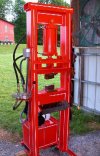- Joined
- Aug 13, 2022
- Messages
- 134
Hello All
I have another thread going asking for info on my Press build and have had great help from all of you especially Ken. I wanted to repost this question as I am in the engineering stage and well just need input.
Wear plate on the forging press slide yes or no needed or not. The thought that I have gathered are they are not really needed on a home type limited use press. But at the same time, I see the valeue. Problem is when I price Aluminum bronze 954 the cost for some simple where plates exceed what I paid for my motor, control and cylinder combined.
Does anyone have pics they can share of were plate they have installed so I can see how they are mounted as to not get screws in the way.
Last question would Delrin wear blocks be an option as I have a ton of that. or would the plastic be to soft????
Thanks Jerry
I have another thread going asking for info on my Press build and have had great help from all of you especially Ken. I wanted to repost this question as I am in the engineering stage and well just need input.
Wear plate on the forging press slide yes or no needed or not. The thought that I have gathered are they are not really needed on a home type limited use press. But at the same time, I see the valeue. Problem is when I price Aluminum bronze 954 the cost for some simple where plates exceed what I paid for my motor, control and cylinder combined.
Does anyone have pics they can share of were plate they have installed so I can see how they are mounted as to not get screws in the way.
Last question would Delrin wear blocks be an option as I have a ton of that. or would the plastic be to soft????
Thanks Jerry
Last edited by a moderator:

